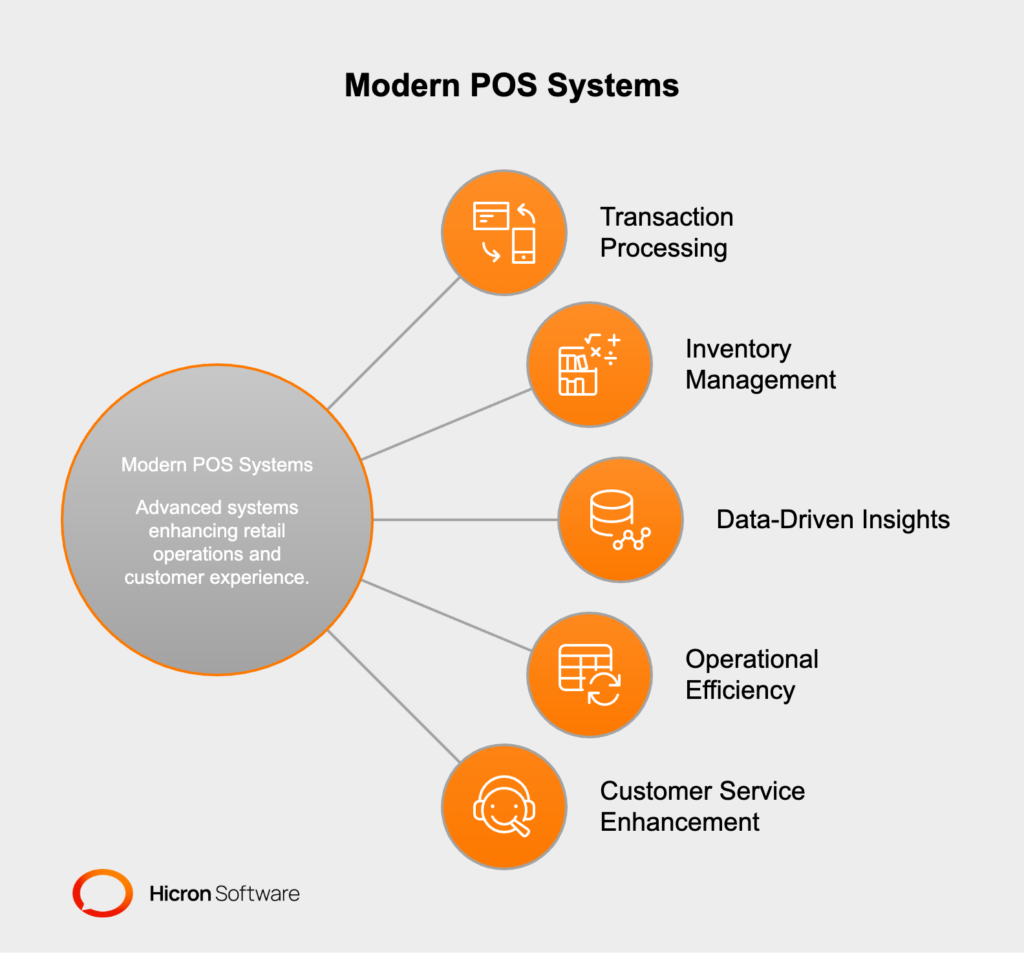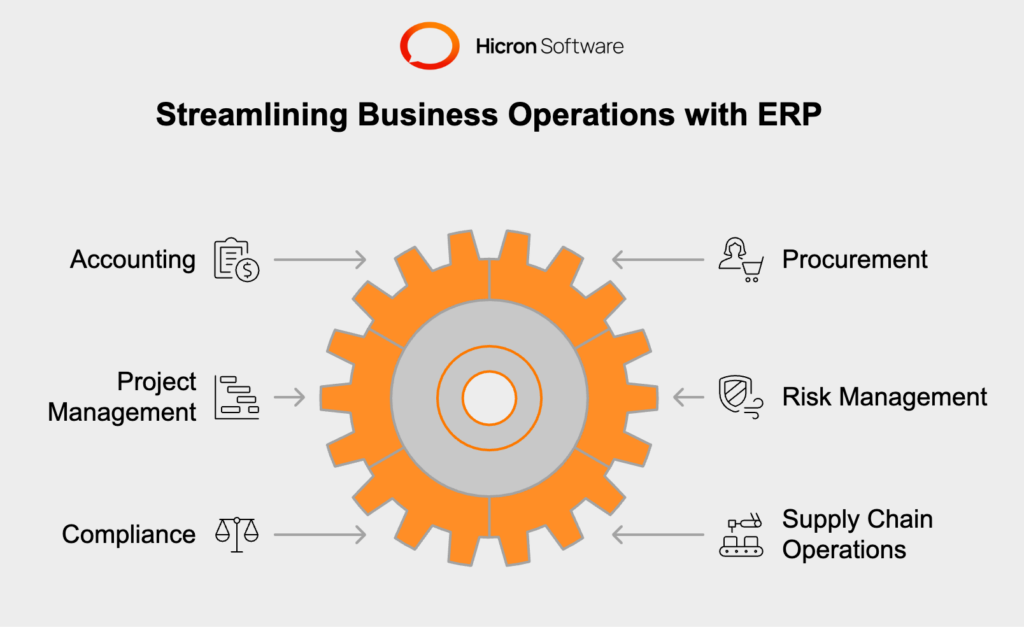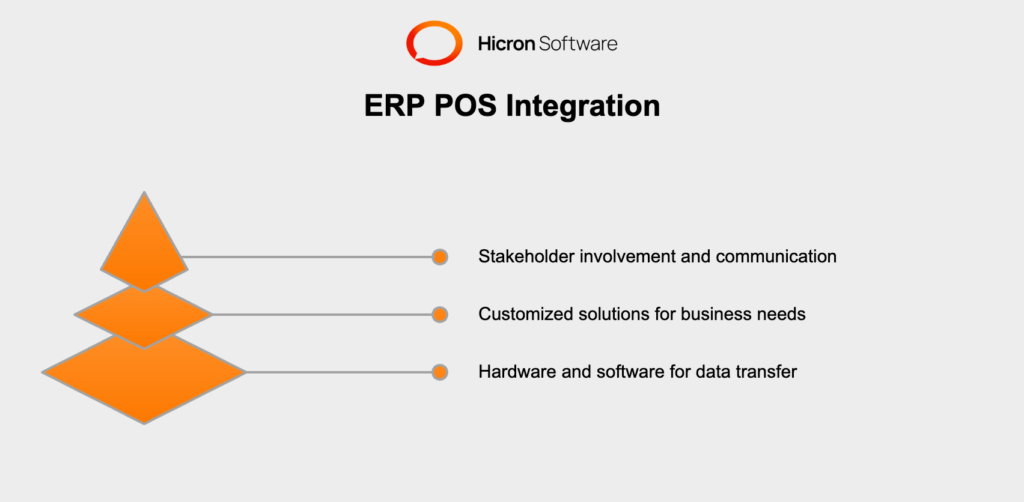What is Automation in DevOps?
- August 01
- 14 min

Point of Sale (POS) and Enterprise Resource Planning (ERP) integration is a critical aspect of modern retail operations that drives efficiency and improves overall business management. POS systems handle transactions at the customer interface, capturing sales data in real time. On the other hand, ERP systems manage back-end operations such as inventory control, supply chain management, and accounting.
POS (Point of Sale) and ERP (Enterprise Resource Planning) integration connects a business’s sales system (POS) with its operations (ERP) to facilitate processes and enhance data flow. This integration brings real-time data synchronization between the two systems, eliminating the need for manual data entry.
We will delve into the functionalities and benefits of each system, discussing how they are used in different industries and their impact on business operations but now let’s have a piece of information, shortly about POS and ERP.
The days of traditional cash registers are long gone, replaced by advanced electronic POS terminals that offer a wide range of features and capabilities.
A modern POS system goes beyond just processing transactions – it acts as the central hub for managing sales and enhancing the overall customer experience, both in physical stores and online shopping platforms. With the ability to accept various payment methods such as credit cards, debit cards, and mobile wallets, retailers can provide convenience and flexibility to their customers.
However, the benefits of a POS system don’t stop at transaction processing. Its data-driven approach empowers retailers to gain valuable insights and make informed decisions. By keeping track of inventory levels, businesses can optimize their stock management, ensuring they have the right products in stock at the right time. Furthermore, the ability to monitor sales data and generate insightful reports allows retailers to identify trends, analyze customer behavior, and refine their marketing strategies.
With this wealth of information at their fingertips, businesses can streamline their operations, reduce costs, and enhance customer service. For example, they can identify their best-selling products and allocate resources accordingly, improving profitability. They can also identify any slow-moving items and take appropriate actions to minimize inventory shrinkage.
A modern POS system transcends its role as a transaction processing tool. It becomes a strategic asset that enables businesses to optimize operations, streamline inventory management, and elevate customer service. By harnessing the diverse features and capabilities of a POS system, retailers can remain competitive in the dynamic and ever-evolving retail landscape of today.

ERP systems streamline business activities, encompassing accounting, procurement, project management, risk management, compliance, and supply chain operations. They provide transparency, integration, and scalability, offering comprehensive tracking and data access across departments. ERP solutions are customizable to meet industry-specific needs, enabling businesses to make informed decisions and optimize processes.
Whether deployed on-premises or in the cloud, ERP systems offer flexibility and scalability to meet the unique needs of different businesses. They serve as centralized hubs that connect different departments and streamline workflow processes. This ensures seamless communication and collaboration across the organization.
One of the key advantages of ERP systems is their ability to track production, logistics, and financials in real-time. This transparency enables organizations to identify bottlenecks, optimize processes, and make data-driven decisions. By having access to accurate and up-to-date information, businesses can enhance their operational efficiency and customer satisfaction.
ERP solutions cater to businesses of all sizes and industries. They offer customizable features that can be tailored to specific industry requirements. Whether manufacturing, retail, healthcare, or finance, ERP systems provide the necessary tools and functionalities to drive growth and success.

To gain a comprehensive view of businesses’ operations, retailers must integrate their POS software with an Enterprise Resource Planning (ERP) system. The integration of POS and ERP is critical in providing retailers with unparalleled visibility into inventory, sales, manpower, and profitability.
The integration of POS and ERP involves connecting front-end operations with back-end functions, such as procurement, warehouse management, accounting, replenishment, and human resources management. By implementing an integrated retail system, retailers can provide their sales personnel with real-time information that enables them to make informed decisions that translate into enhanced customer service experiences.
In addition, integrating POS with an ERP system eliminates data duplication, ensuring the integrity of information. This correlation helps in avoiding inventory mismanagement risks, reduces redundancies, and boosts overall productivity.
Traditionally, inventory sales and purchasing are managed separately by the POS and the ERP/financial system, respectively. Integrating these two systems prompts proactive processes to track inventory levels and automatically trigger purchase orders when inventory levels are below acceptable thresholds.
For retailers struggling to keep track of inventory details and set appropriate prices for slow-moving goods, integrating their POS and ERP is the solution. By receiving real-time information about non-moving inventory, retailers can make timely decisions such as offering discounts to clear out stock and maximize floor space utilization.
Integrating ERP with POS is important for companies looking to effectively manage supply and demand. Many retailers have already started adopting integrated POS systems, signaling a positive trend towards using system integrations. To ensure a seamless integration process, retailers can partner with a retail systems integrator offering system integration services to experience the benefits of an ERP POS system. With the right integration strategy in place, retailers can gain unparalleled insight into their operations, improve decision-making, and drive profitability.
The integration of ERP and POS systems has become increasingly important for businesses looking to streamline their operations and improve their bottom line. This process involves the merging of data between these systems to provide real-time insights and enable efficient management of inventory, orders, and finances.

The ERP POS integration process involves several key components, including
By adopting a holistic approach to this process, businesses can derive significant benefits, including improved efficiency, accuracy, and profitability.
Integrating ERP and POS systems has become a top priority for businesses in the retail industry. Seamlessly connecting these two systems can revolutionize operations, streamline processes, and drive growth. We will explore the essential steps for successfully integrating POS and ERP systems. By following these steps, businesses can unlock the full potential of their retail operations, enhance efficiency, gain real-time insights, and provide exceptional customer experiences.
When integrating ERP and POS systems, businesses may encounter several key challenges. These challenges include:
The integration of POS and ERP systems has become a necessity for efficient management of business operations, particularly in the retail industry. With retailers facing increasing competition and cost-cutting pressures, the benefits of integrating software systems are clear. It allows businesses to streamline and automate key business processes, as well as gain valuable insights into their operations, inventory management, sales analysis, and customer data.
|
Best Practice |
Details |
Importance |
|
Understand the Systems |
Gain a thorough understanding of POS and ERP systems, including their roles in capturing sales data and managing inventory, accounting, and other functions. |
Ensures effective integration by aligning the functionalities of both systems. |
|
Use Standardized Protocols |
Integrate systems using standardized protocols and interfaces to establish a secure and stable connection. |
Reduces errors and ensures a seamless and secure integration process. |
|
Monitor and Maintain Integration |
Perform regular checks to ensure smooth operation, identify bottlenecks, and address potential issues early. |
Prevents costly operational disruptions and safeguards data integrity. |
|
Work with a Systems Integrator |
Partner with an experienced retail systems integrator to evaluate existing systems and design customized integration solutions. |
Leverages expert insights to ensure tailored, efficient, and reliable integration. |
The best practice for POS ERP integration is to understand the intricacies of the two systems that will be integrated. POS systems are designed to capture sales data, while ERP systems are designed to manage inventory, accounting, and other functional areas. A deep understanding of these two systems is necessary to ensure that the integration is effective and seamless. Integration should be done through the use of standardized protocols and interfaces to provide a secure and stable connection between the two systems. This can be achieved by working with experienced system integration consultants or a system integration service provider.
Another important one for POS ERP integration is to regularly monitor and maintain the integration for optimal performance. This involves performing regular checks on the integration system to ensure that it is running smoothly and to identify any bottlenecks or issues that may arise. Proper maintenance can help to avoid costly system breakdowns, data loss, or other issues that could negatively impact business operations.
Retailers should consider working with a retail systems integrator when integrating their POS and ERP systems. A retail systems integrator has extensive experience in integrating retail software systems and can provide valuable insights into the best practices for integrating these systems. They can help to evaluate current systems, offer recommendations for improvement, and design and implement a customized solution that fits the unique needs of the business.
With the right system integrations in place, you can streamline processes, improve inventory management, and enhance customer experiences. Take advantage of the expertise of a reliable retail systems integrator who can guide you through the entire process, ensuring compatibility and avoiding data conflicts.
By harnessing the potential of an ERP-POS integration, you’ll have access to consolidated and consistent reporting, enabling you to make data-driven decisions with ease. Optimize forecasting accuracy, streamline financial management, and boost operational efficiency across your organization. Schedule a consultation!
POS and ERP integration connects a business’s point-of-sale (POS) system, which handles front-end transactions, with its enterprise resource planning (ERP) system, which manages back-end operations like inventory, accounting, and supply chain management. This integration creates a seamless flow of data between the two systems, allowing real-time synchronization of sales data, inventory levels, and financial information. By eliminating the need for manual data entry, integration reduces errors and streamlines workflows, providing businesses with a unified platform for managing operations efficiently.
Integrating POS and ERP systems is crucial for enhancing operational efficiency and gaining a comprehensive view of business operations. Businesses benefit from real-time data sharing between the front-end and back-end, resulting in faster decision-making and improved accuracy. For example, integrated systems enable automatic inventory updates and synchronized sales reports, which can reduce redundancies and ensure data consistency. This unified approach not only saves time and resources but also improves customer service by ensuring accurate stock availability and faster transaction processing.
The integration of POS and ERP systems offers several compelling benefits. It improves inventory management by providing real-time updates on stock levels and automating reordering processes. Businesses can access detailed sales reports and customer data, enabling them to identify trends, make informed decisions, and refine marketing strategies. Additionally, integration reduces the risk of data errors by synchronizing information across systems and eliminates redundancies caused by duplicate data entries. Ultimately, it creates a more streamlined workflow that enhances operational efficiency and customer satisfaction.
Integrating POS and ERP systems involves several key steps to ensure a seamless connection. First, assess your business needs, such as inventory tracking or sales reporting, to identify integration goals. Next, evaluate your existing POS and ERP systems to confirm compatibility. Choose an integration method, such as direct API or middleware platforms, based on the complexity of your operations. Map out the data fields and workflows that need to be synchronized to guarantee consistency. Establish data synchronization, deciding whether real-time updates or periodic syncing is appropriate. Finally, test the integration rigorously to ensure functionality and accuracy, and train employees to efficiently use the integrated system.
Several challenges may emerge when integrating POS and ERP systems. Compatibility issues can arise if the systems use different data formats or protocols. Data synchronization errors, such as duplicates or missing information, can disrupt operations. Security risks are another concern, as sensitive financial and customer data must be protected during and after integration. Businesses also need to ensure scalability, as the integrated system should support future growth, additional applications, and increased data flow. Addressing these challenges requires careful planning, expert guidance, and ongoing maintenance.
Integrating POS and ERP systems revolutionizes inventory management by providing real-time transparency. The systems work together to automatically update inventory levels after every sale, ensuring stock data is always accurate. Integration enables automatic reorder alerts when inventory falls below predefined thresholds, preventing stockouts and overstock situations. Additionally, slow-moving or excess inventory can be identified early, enabling businesses to take proactive measures such as offering discounts to clear shelf space. This level of precision ensures efficient resource allocation and enhances profitability.
Hiring a systems integrator is highly recommended for businesses considering POS and ERP integration. A professional integrator has the expertise to evaluate your current systems and business needs to recommend the most suitable integration approach. They also ensure that the process is executed smoothly, with minimal disruptions to your operations. A systems integrator can customize solutions to address unique business requirements and provide ongoing support to resolve any issues that arise post-integration. Partnering with an expert ensures a seamless and effective integration process, maximizing the benefits for your business.
